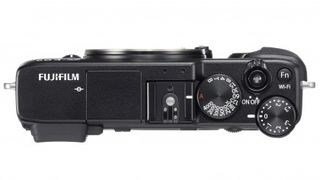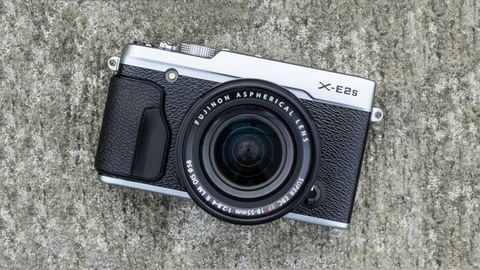Why you can trust TechRadar
The X-E2S continues the largely agreeable design of its forebears, with a sturdy metal top plate complete with milled dials, together with a textured wrap around its body and large, clearly marked buttons on the rear plate. While the camera doesn't quite feel as solid in the hands as its X-Pro2 elder brother, this is expected for a camera at a cheaper price point and it's difficult to imagine it coming to any serious harm.

As the X-E2S has an Auto Macro feature, there's no need for a dedicated button to enable closer than normal autofocusing. This means that the top direction pad button, as well as the bottom button (marked AF on the X-E2) are more likely to be customised by users. By default, the quartet of direction controls access Film Simulation mode, AF mode, AF point and flash mode, which is a logical set. A further change from the X-E2 concerns the button in the very bottom left hand corner; whereas this was previously a function button, this now accesses a full Auto mode.
What's particularly nice to see is that the size and torque of the exposure compensation dial means it is nowhere near as prone to being knocked out of place as this type of dial is on many other cameras. The now-finer ridges on the rear command dial also feel nicer to the thumb than on the X-E2, although the Q button occupies the same space beneath the hot shoe as before, which is shame as a control used this frequently really deserves a place where it can be accessed as easily as possible. The hump to the right of the thumb rest, where this control is found on the X-Pro2 is the obvious candidate, particularly as this is home to the less-frequently used AF-L and AE-L controls.
The grip has been slightly reworked, now sporting a flat rubber section on the side closest to the lens. The camera itself is not heavy, although with the XF 18-55mm f/2.8-4 R LM OIS kit lens attached, the grip feels like it ought to be more substantial if it's to serve its purpose (although this does help to keep its profile down).

At its default setting the LCD screen appears somewhat underpowered in bright sunlight and it can be difficult to assess some scenes (particularly those with a wider dynamic range). However its brightness can be increased (and decreased) by five levels from the standard setting, which makes a considerable difference. In similar shooting conditions the viewfinder requires a hand cupped around it, otherwise it too can be difficult to see clearly.
In more average conditions, however, the viewfinder performs very well. It's bright and detailed, and displays very little lag when you change the framing, with the effective lens-based image stabilisation helping to steady the view. Only a little noise creeps in when shooting in darker conditions, with details generally remaining clear enough to accurately assess focus, even when manually focusing the lens (although aids such as the camera's focus peaking function are available). It doesn't tilt in any way, although this feature is provided on the X-T10 which has similar specs to the X-E2S and could be a good alternative.

